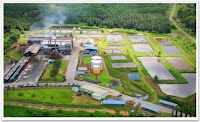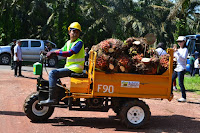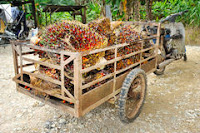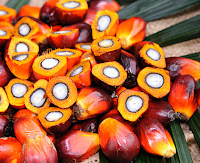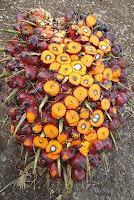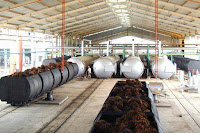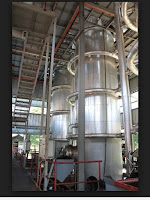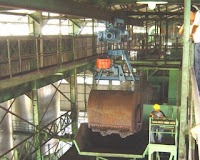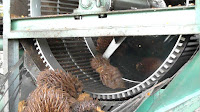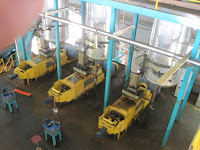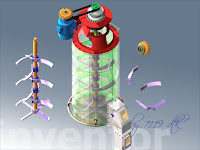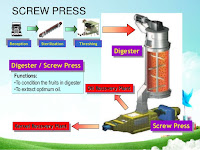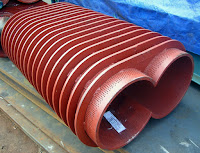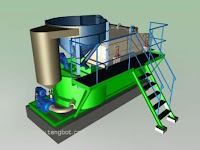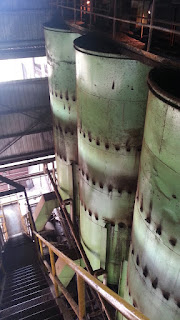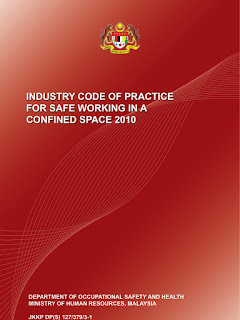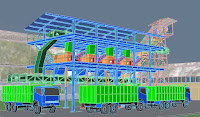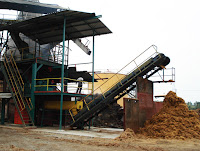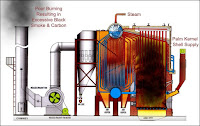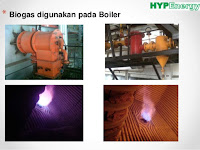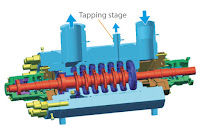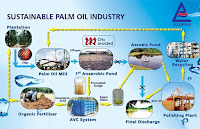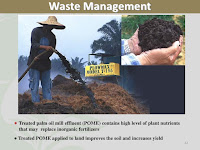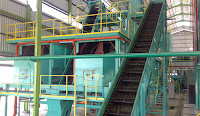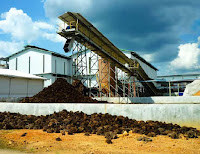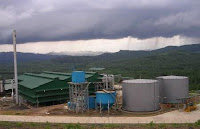Multitasking tasks in the mill produce multitasking managers and engineers. From basic fundamental of mechanical engineering, electrical, chemical, civil, human resources, accounting, marketing, quality management, public relation, teacher, lawyer and also actor! Yes. All in one. Congratulation if you are one of them!
- FFB Reception
- Weighbridge 60 mt. One/two clerk depend on one shift or two shift.
- FFB Transportation. Land & Water.
- Road is the key of estates operation.
- Delivering the FFB from Estates to Mills is a challenging tasks to Planters. Whenever the loaded lorry arrive at mill's gate, millers should give respect to them by accepting their consignment to appreciate their hard work. Off course for the good FFB quality.
- Annual calibration by Metrology / Service provider - Avery.
- Grading.
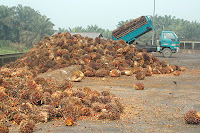
- Grade the FFB quality based on MPOB Grading Manual-Latest 2015 Edition.
- 10 category FFB. Freshness. Unripe. Underipe. Ripe. Overipe. Long stalk. Empty. Rotten. Parthonorcorpic. Rotten. Wet.
- Oil palm profile. To determine the based OER. Year of planted. Weight of bunch.
- Based OER.
- Penalty based on FFB quality
- Certified FFB graders by MPOB.
- Helper 5 to 10 psn depend on the FFB daily reception.
- One loader to push the FFB.
- Good quality FFB. 95% ripe, 5% overipe, 5% underripe.
Loose Fruit Analysis to determine the accuracy and measure the quantity of loose fruits.
- Sterilization
- Type of sterilizer. Horizontal. Vertical. Tilted. Spherical. Continuous.
- Function :
- To stop FFA increasing.
- To prepare the fruit/bunch for next processing.
- One peak, three peaks, multi peaks.
- Pressure 3.2 bar or 120 deg C.
- Cages size 3,5,7.5,10,15 or 20 mt each.
- Crane.
- Dearation.
- Cycle.
- Capstan.
- Cantilever.
- Threshing
- To separate the loose fruit and bunch.
- RPM.
- Type of threshing. with or without shaft.
- Single threshing or double threshing.
- Bunch crusher.
- Pressing
- Number and capacity of press determine the TPH of the mills.
- Capacity : 10. 15, 20, 25 mt/hr
- Twin screw. Cages. Screw. U liner. B plate. RH for replacement 700 to 1000 hrs.
- Digester. RPM. Long arm, short arm. S type. C type. Bottom plate. Temperature 95 deg C. Level 3/4. 3000 or 3500 liters capacity.

- Losses. Nut breakage. Oil loss.
- Cake Breaker Conveyor.
- Nut Plant
- Ripple Mill. Nut breakage. Cracking Efficiency. Kernel breakage 12 to 15%.
- Nut Silo. Retention time.
- Hydrocylone or Claybatch.
 Ripplemill. Cracking the nut. Determine the kernel breakage at range 10 to 15 % is the better option rather than cracking efficiency (96-98%). Reduce kernel loss at air separation.
Ripplemill. Cracking the nut. Determine the kernel breakage at range 10 to 15 % is the better option rather than cracking efficiency (96-98%). Reduce kernel loss at air separation.
- Kernel losses. Shell. Dirt & Impurities.
- Kernel Plant
- Moisture.
- Kernel Silo. Heater.
- Kernel Storage
- Kernel bunker.
- To clean kernel silo and kernel bunker at least once a year to prevent fire.
- Confined Space procedure to apply.
- Clarification
- Vertical Clarifier.
- Sand Trap.
- Pure Oil Tank
- Vacuum Drier.
- Sludge Separator or Decanter.
- Sludge Tank.Vibrating Screen
- Deoiling Tank.
- Sludge Pit.
- Condensate Tank.
- Vibrating Screen. Mesh 30 or 40.

- EFB
- Bunch Crusher.

- EFB Press. Doe requirement to put roofing. Demand for solid fuel encourage more mills to install pressing and shredding.
Handling of EFB at mills required loader. Some mills put excavator to load the efb to lorry before transfer to estates as mulching.
- Shredded EFB
- Palleting Machine.
- Long fiber.
- Mulching
- Composting.
- EFB ratio to FFB : 23%
- Boiler & Power Plant
- Size of boiler determine by the TPH of the mills and total electricity required by all mill's sections.
- Ranging from 18, 27, 35, 45 mt/hr steam generating.
- Vickers. Mechmar. Boilermech.
- Water tube boiler. Biomass.
- Type of fuel : Mesocarp fiber. Palm kernel shell. Shreded empty bunch. Gas from Effluent treatment plant.
- Steam engineer. Boilerman. Engine Driver. Grade II, 1 DOSH Certificate. MSIEA.
- DOSH Annual Inspection. 10 days.
- Diesel Generator ranging 400, 500, 600 kw. Back up power suply during non running of steam turbine.
- Steam turbine to generate electricity. Ranging 1000, 1200, 1400, 2000, 2,400 kw. Nadroski. PMT.
 Manual Racking for Furnace Floor without moving grate. To install Vibrating Grate or Pulsating Grate to remove clinker.
Manual Racking for Furnace Floor without moving grate. To install Vibrating Grate or Pulsating Grate to remove clinker.
Working Floor to feed solid fuel to boiler. Minimize the using of loader to feed the boiler fuel.
- Back pressure receiver. Steam supply for processing. heating.
- Boiler accessories. Manual racking. Pulsating grate. Vibrating grate. Soot blowing. Super heater tube. Air preheater. economizer.
- Boiler water teratment. Internal treatment. Softener. Vacuum Dearator. Hot water tank. Feed water pump.
- Working floor. Loader. Elevator. Conveyor.


- Effluent Treatment Plant
- Type of ponds. Cooling Pond. Anaerobic Ponds. Aerobic Pond. Polishing Ponds.
- Tertiary plant. Batching System. Filtration. RO. Decanter. Belt Press. Dewatering system.
- Land irrigation.

- Biogass. Flaring. Gas turbine.
- Biotube.
- Desludging.

- PH, BOD, COD, Oil, SS. Influent parameters.
- Final discharge standard parameters. Effluent.
Spherical Sterilizer
 Old style. FFB feeding to 3.5 mt Cages. Labor intensive of feedding ffb, arrranging cages and using of machinery such as loader and capstan. Safety issue and space. Maintenance of cages wear and tear.
Old style. FFB feeding to 3.5 mt Cages. Labor intensive of feedding ffb, arrranging cages and using of machinery such as loader and capstan. Safety issue and space. Maintenance of cages wear and tear.
Spherical steriliser
 Bunch Crusher using in Double Threshing System to reduce USB loss. Prepare the bunches for the EFB pressing or Shredding.
Bunch Crusher using in Double Threshing System to reduce USB loss. Prepare the bunches for the EFB pressing or Shredding.
Digester
Cast steel screw press.
Biotube for desludging.
Typical method of desludging.
Land Irrigation.
Filter Frame Press to reduce suspend solid.
- Workshop
- Store
- Water Treatment Plant


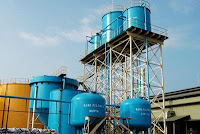
- Source of water. River. Catchment pond. Man made pond. Sea.
- Water intake quality determine the treatment system.
- Alum. Soda. PPM. Dosing system.

- Mass Transfer
- To convey the mass, conveyor, elevator, pump are used.
- Pumps. Multistage. Open Impeller. Semi. Closed Impeller. Centrifugal.
- Storage Tank
- Tank Capacity 1000, 1500, 2000, 2500 mt.
- Despacth Tank.
- Heating.
- Storage procedure.
keyword for search : palm oil mill, palm oil, steriliser, thresher, digester, press, boiler, turbine, kernel silo, oer, ker, mpob, doe, dosh, water treatment plant, effluent treatment plant, efb, mesocarp fiber, shredded efb, laboratory, oil clarification, kernel silo, kernel bunker, conveyor, elevator, malaysia, sabah, borneo, ioi, boustead, engineering, mechanical, steam engineer, internal combustion engineer, genset



